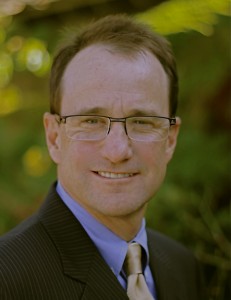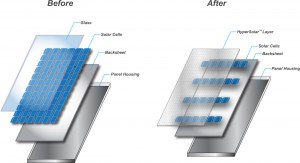 The real alternative energy revolution takes place in small start-ups whose R&D efforts keep improving clean technology to make it applicable on a mass scale. One such company is Hypersolar, whose focus is to develop a technology that can magnify sun power to increase the power output of solar cells. The company is developing the world’s first thin and flat light magnification layer for direct application on top of standard solar cells to increase their power output. “Our plan is to move to the prototype stage in 2011 and then to a commercial productâ€, Hypersolar CEO Tim Young said in a statement at the time. Energy Refuge caught up with Mr. Young to talk about a solar powered future and to hear his thoughts on the Obama’s administration’s recent pronouncement on the future of energy.
The real alternative energy revolution takes place in small start-ups whose R&D efforts keep improving clean technology to make it applicable on a mass scale. One such company is Hypersolar, whose focus is to develop a technology that can magnify sun power to increase the power output of solar cells. The company is developing the world’s first thin and flat light magnification layer for direct application on top of standard solar cells to increase their power output. “Our plan is to move to the prototype stage in 2011 and then to a commercial productâ€, Hypersolar CEO Tim Young said in a statement at the time. Energy Refuge caught up with Mr. Young to talk about a solar powered future and to hear his thoughts on the Obama’s administration’s recent pronouncement on the future of energy.
ER: What’s your overview of the Obama administration’s “Blueprint for a Secure Energy Future“? What do you think is missing from the plan?
TY: I applaud President Obama for focusing on the environment, but even more importantly for focusing on the security aspect of our energy policy. Our nation will never be secure unless we control the production of energy. We consume 20 million barrels of oil a day, of which 13 million barrels is from foreign sources. We are spending $1 billion a day on imported oil. The money we spend on foreign oil makes up 80 percent of our national trade deficit. Imagine the impact on our economy if we were able to stanch this tremendous outflow of funds, turning it instead to the creation of new jobs and prosperity. But we are facing a Catch-22: We need more funding for innovation – funding for research on energy makes up only a tiny percentage of the federal budget – but fiscal pressures are limiting our ability to invest in the future. One solution is to be more selective about how we use the funds that are available. Obama’s Blueprint has put solar in the spotlight, which will attract additional funds for innovation. But the plan needs to identify strategies to promote the funding of what are called “disruptive technologies†– technologies that represent game-changing breakthroughs – as opposed to continuing to pour money into the accelerated deployment of “sustained technologies,†or traditional technologies that may not be economically viable over the long term without government subsidies.
ER: A goal of the SunShot initiative is the advancement of sunlight-to-energy solar cell technologies. What is your expert view on how the government can achieve that?
TY: The goal of the U.S. Department of Energy’s SunShot initiative is to make solar technologies cost-competitive with other forms of energy by reducing the cost of solar by about 75 percent before the year 2020 under the premise that reducing the cost of solar to equal that of energy from traditional sources (or 5 to 6 cents per kilowatt hour without subsidies) will result in the rapid, large-scale adoption of solar. But it is my belief this goal will not be achieved through incremental improvements in solar cell efficiency; rather, it will be achieved by the development of a disruptive technology that will change the market for solar in an unexpected way. We believe HyperSolar has the ability to dramatically alter the market for solar in the same way that the introduction of the Internet or the debut of the Ford Model T, which made low-cost automobiles available to the masses, dramatically altered the technology and automobile industries.
The solar cell is inherently inefficient. The original solar cell, which was invented in 1883, had an energy-conversion efficiency of less than 1 percent, while the efficiency of the first viable photovoltaic cell, Bell Labs’ “Solar Battery,†which was developed in 1954, was about 6 percent. After nearly 130 years of research and development, the average energy conversion efficiency of the solar cell is now only about 15 percent, meaning that only a fraction of the sun’s energy is converted into electricity. Moreover the silicon solar cell appears to be reaching its theoretical limits of efficiency. Because of this, large numbers of expensive solar cells have to be used in order to generate substantial amounts of electricity. While other types of cell materials are more efficient, they are even more expensive.
“We should be looking for the next-generation tools that will shatter conventional paradigms about the nature of our energy future”
In order to become competitive with energy generated from traditional sources, solar has to become more efficient. Rather than focusing on incremental improvements in cell efficiency, HyperSolar is developing a breakthrough technology that can be viewed as a “performance enhancer†for solar. The HyperSolar technology takes the form of an acrylic topsheet that, when applied to an off-the-shelf solar panel, boosts performance by 300 percent. As a result, the number of cells, the most expensive element in a panel, can be reduced by 66 percent, with a corresponding reduction in cost. HyperSolar believes that it will eventually achieve concentrations of 400 percent. Moreover, although the HyperSolar technology is now being developed for use with silicon cells, it can be used with any type of cell material: whatever a cell’s efficiency, HyperSolar will boost it.
The photovoltaics subprogram of the SunShot initiative focuses on new devices and processes, prototype design and pilot production, and systems development and manufacturing. This is all good, but more funding is needed for disruptive technologies. As President Obama has noted, “None of us can predict with certainty what the next new industry will be…†because of the fundamentally unpredictable nature of technological progress. When it comes to trickle-down economics, the most efficient means of stimulating economic development is through the creation of a reservoir of funding for innovative technologies with the potential to leapfrog over sustained technologies in terms of environmental benefits, easy scalability and rapid payback. In short, we need technologies that will boost performance by 500 or 1,000 percent, not 1 or 2 percent.
ER: What must be done to achieve grid parity for solar?
TY: If balance-of-system costs (the costs of everything but the panel) can be held in check, grid parity can be achieved in the near future, especially in light of the fact that the cost of electricity generated from traditional sources continues to rise. In fact, utility-scale unsubsidized solar has already been demonstrated to be competitive with electricity generated from fossil fuels in California and Nevada. But achieving grid parity across the country will only be achievable through a breakthrough technology, which is why HyperSolar is committed to developing a new technology that doesn’t rely on increases in cell efficiency to increase production. I would also pose this question: why stop at grid parity? Grid parity may eventually be achieved across the country through incremental increases in cell efficiency – although I’m not even sure about that – but from an economic standpoint, it would be preferable if the cost of solar energy was half as much as that of energy generated from fossil fuels.
ER: What difficulties do companies face when they try to get innovative technologies into production and how could the federal government help?
TY: The biggest hurdle is financing. The recent economic downturn has limited the availability of private funding in general, and private funding for new green technologies in particular. I recently attended an investment seminar at which a prominent venture capital firm announced that it was dissolving its green fund because it didn’t believe renewables would be a viable investment until the price of crude oil reaches $150 a barrel (as of this writing, it was $109). In the absence of significant investment by the private sector, it becomes important for federal government to lead the way. Although a free-enterprise system led by the private sector is the most powerful driving force for innovation, the nature of the risks involved in large-scale energy projects requires the participation of government. Many of our most significant technological breakthroughs have come as a result of such public-private partnerships. As mentioned, however, in allocating funds it is important not to make the mistake of putting all of our eggs in one basket: namely, spending significant amounts on infrastructure that will require financial subsidies to survive. Rather, we should be looking for the next-generation tools that will shatter conventional paradigms about the nature of our energy future.
ER: Do you think small solar has a bigger role to play than large-scale solar farms in terms of a renewable energy future? Or is it the other way around?
TY: Large-scale solar has the biggest impact at the least expense. The economies of scale aren’t there for smaller projects. But smaller projects play an important public relations role in winning acceptance for solar by raising the profile of the technology and educating the public. There’s nothing like a rooftop solar system on a neighbor’s house, a local school or a community center for demonstrating the benefits of a new technology.
ER: Bloomberg recently said that the cost of solar will halve by 2020. Do you agree with this forecast? How much per watt do you think solar will cost by 2020?
TY: The report from Bloomberg New Energy Finance said that solar is already a viable alternative to fossil fuels in most sunny regions. The report also predicted that solar installations would surge in the next two years as the cost of energy from solar rivals that produced from coal. But, as I have noted, the achievement of grid parity is only the first milestone. In order to truly gain control of our energy future, we need to go beyond grid parity. We need a source of clean energy that is so inexpensive that it is beyond control or manipulation by governments, despots, lobbyists, corporations or politicians. By putting the control of the sun into the hands of consumers, we can create a future in which the sun will power an energy-rich, western-style way of life not only for early adopters in U.S. states with attractive financial incentives for solar, but for billions of people around the globe.
Follow us @energyrefuge







With the Hypersolar design, will the PV cells be degraded by the resutant higher temperature at 400% output ?